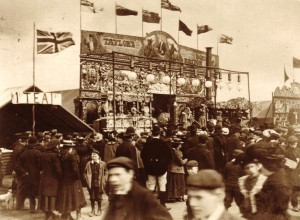The Fairground Bioscope Show
(Contains Link to Video Production)

The heyday of the travelling bioscope (early silent cinematograph) shows was between the late 1890’s and the First World War. Showfolk presented picture shows on the fairground. The show-fronts of these bioscope shows became very elaborate with ornate carvings. Most shows also featured a large fairground organ situated on the show-front. All the electricity was produced by steam power from a steam road locomotive stationed adjacent to the show. A belt from the steam engines’ flywheel would drive a dynamo mounted on the front of the engine. The dynamo could produce 110 volts D.C. – 40 amps @ 750 rpm, suitable for powering the carbon arc lighting, projector and organ.
The show-front (or bally) was used by the showfolk to draw crowds to the bioscope presentation and to entertain the crowds during an existing cinematograph show. Paraders would pitch to the crowds with displays of various dances and songs. The powerful fairground organ would also play popular music of the period.

Competition between showfolk was such that the standards of these pre-shows became more and more varied and professional. At some of the larger Charter Fairs, up to three bioscope shows could be built-up adjacent to each other.
In the early days of these bioscope shows, the showfolk would produce their own silent picture shows. Later on, these films were professionally produced and distributed by specialist film companies. There was always a concern regarding the flammability of nitrate film stock. Several fires resulted in regulations to isolate the projector and projectionist from the audience.
To watch the video, ”The CINEMA at the DAWN of the 20th. Century” click below
This Video Presentation is the Copyright of the EAI Picture Library – All Rights Reserved
